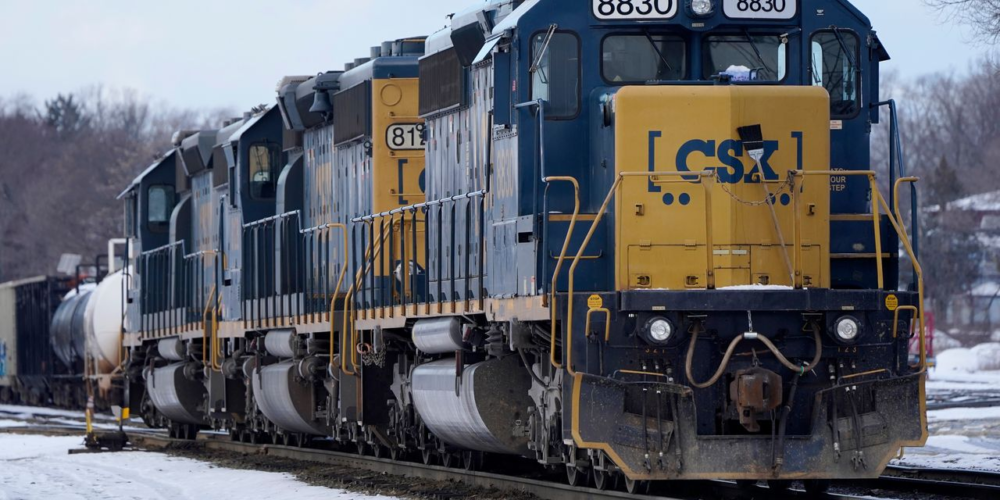Shares of CSX Corp. rose in extended trading Thursday after the railroad giant’s first-quarter results beat expectations, as price increases and a bump in coal demand offset a dip in how much product the company shipped overall.
The railroad operator, whose network covers much of the Eastern U.S., issued the results even as import demand fades from the heights seen during the pandemic-inspired buying binge in 2021, and as the company tries to staff up to improve delivery service. The railroad industry also faces bigger questions surrounding safety standards and labor tensions.
“Pricing was up year-over-year as we benefited from favorable contract repricing and higher fuel surcharges,” Kevin Boone, executive vice president of sales and marketing, said during CSX’s earnings conference call. “For the remainder of the year, we will continue to see benefits from a supportive pricing environment and improve rail service.”
CSX
CSX,
reported first-quarter net income of $987 million, or 48 cents a share, compared with $859 million, or 39 cents a share, in the same quarter last year.
Revenue for CSX rose 9% to $3.71 billion. That compared with $3.4 billion in the prior-year quarter. Management said the sales gains were “driven by solid volume growth in merchandise and coal, higher fuel surcharge and pricing gains.” Fuel surcharges are fees that freight carriers charge to offset fluctuating fuel costs.
Analysts polled by FactSet expected adjusted earnings per share of 43 cents, on revenue of $3.58 billion. They expected shipping volumes to dip 0.9%.
Shipping volumes overall fell 1% during the quarter, dragged by CSX’s large intermodal business, which connects customers shipping things to rail via other modes of transportation, like trucks. Boone said that business had been hurt by weaker import volumes, as softer consumer demand kept retailers’ stockpiles of unsold goods fatter.
However, volumes for coal jumped 19%. Volumes also rose for metals and equipment, as well as food and agricultural products. They rose as well for things related to autos, despite production snags for some of CSX’s customers. The company said some of those issues were “moderating,” and were upbeat on those volumes through the rest of the year.
Shares rose 2.9% after hours.
CSX reported after its Western-U.S. peer Union Pacific Corp.
UNP,
put out quarterly results earlier in the day. Those results beat expectations, even as higher costs and and severe weather — including flash-flooding in California and freezing weather in the Midwest — weighed on profits.
Both rail operators reported as scrutiny intensifies over railroad safety following the derailment in February of a Norfolk Southern
NSC,
train carrying toxic materials in Ohio, and companies’ handling of railroad crews. However, some analysts noted that CSX’s rail service had gotten better.
President Joe Biden in December signed legislation preventing a railroad-worker strike, following worker dismay over what they said was scant paid sick time. The industry, after slimming down crews on trains in an effort to cut costs and compete with rival forms of shipping, has now struggled to attract, bring back and retain workers.
Rail operators are still trying to work out agreements with their unions. CSX has reached deals with several unions this year.
“Going forward, we’re closely watching if paid-sick leave agreements can extend to all railroad unions, and the impact these agreements will have on attrition,” Bascome Majors, an analyst at Susquehanna, said in a note to clients on Wednesday.
Any strike risked halting shipments and damaging the economy, even if it were to have lasted for only a few days. More recently, possible signs of labor-related friction have emerged at the ports of Los Angeles and Long Beach, as unions and terminal operators try to agree on a contract.
Asked by an analyst about the possible fallout of those negotiations, Boone downplayed the impact. He said there was an ongoing “secular advantage” to shipping goods on the water to the East Coast, where investments in ports have increased to compete with the gateways on the West Coast.
Meanwhile, inflation and concerns of a recession have weighed on customer demand, cutting into the amount of items railroads and trucks haul from one place to another.
“Coming into this year, our near-term conviction investing in the rail sector was low due to a weak freight market, higher inflationary costs, moderating assessorial revenue, increased regulatory pressure and the need for the industry to maintain higher resource levels (headcount) during this downturn to improve service performance / resiliency through the cycle,” Stephens analysts said in a note last month.
“We believe all of these narratives have played out in recent months (weighing on 1Q23 results), with an added layer of uncertainty around the potential regulatory response to the recent NSC derailment,” they continued.
Shares of CSX are down 12.7% so far this year. By comparison, the S&P 500 Index
SPX,
has fallen 7.7% over that period.



